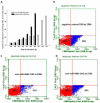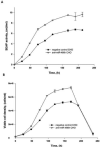Stable inhibition of mmu-miR-466h-5p improves apoptosis resistance and protein production in CHO cells
- PMID: 23376592
- PMCID: PMC3644357
- DOI: 10.1016/j.ymben.2012.12.004
Stable inhibition of mmu-miR-466h-5p improves apoptosis resistance and protein production in CHO cells
Abstract
MiRNAs have been shown to be involved in regulation of multiple cellular processes including apoptosis. Since a single miRNA can affect the expression of several genes, the utilization of miRNAs for apoptosis engineering in mammalian cells can be more efficient than the conventional approach of manipulating a single gene. Mmu-miR-466h-5p was previously shown to have a pro-apoptotic role in CHO cells by reducing the expression of several anti-apoptotic genes and its transient inhibition delayed both the activation of Caspase-3/7 and the loss of cell viability. The present study evaluates the effect of stable inhibition of mmu-miR-466h-5p in CHO cells on their ability to resist apoptosis onset and their production properties. The expression of mmu-miR-466h-5p in the engineered anti-miR-466h CHO cell line was significantly lower than in the negative control and the parental CHO cells. These engineered cells reached higher maximum viable cell density and extended viability compared with negative control and parental CHO cells in batch cell cultures which resulted in the 53.8% and 41.6% increase of integral viable cells. The extended viability of anti-miR-466h CHO cells was the result of delayed Caspase-3/7 activation by more than 35h, and the increased levels of its anti-apoptotic gene targets (smo, stat5a, dad1, birc6, and bcl2l2) to between 2.1- and 12.5-fold compared with the negative control CHO in apoptotic conditions. The expression of secreted alkaline phosphatase (SEAP) increased 43% and the cell-specific productivity increased 11% in the stable pools of anti-miR-466h CHO compared with the stable pools of negative control CHO cells. The above results demonstrate the potential of this novel approach to create more productive cell lines through stable manipulation of specific miRNA expression.
Published by Elsevier Inc.
Figures






Similar articles
-
A novel microRNA mmu-miR-466h affects apoptosis regulation in mammalian cells.Biotechnol Bioeng. 2011 Jul;108(7):1651-61. doi: 10.1002/bit.23092. Epub 2011 Mar 11. Biotechnol Bioeng. 2011. PMID: 21337326 Free PMC article.
-
Glucose depletion activates mmu-miR-466h-5p expression through oxidative stress and inhibition of histone deacetylation.Nucleic Acids Res. 2012 Aug;40(15):7291-302. doi: 10.1093/nar/gks452. Epub 2012 May 25. Nucleic Acids Res. 2012. PMID: 22638581 Free PMC article.
-
Enhanced cell culture performance using inducible anti-apoptotic genes E1B-19K and Aven in the production of a monoclonal antibody with Chinese hamster ovary cells.Biotechnol Bioeng. 2007 Jul 1;97(4):877-92. doi: 10.1002/bit.21222. Biotechnol Bioeng. 2007. PMID: 17099908
-
miR-CATCH Identifies Biologically Active miRNA Regulators of the Pro-Survival Gene XIAP, in Chinese Hamster Ovary Cells.Biotechnol J. 2018 Mar;13(3):e1700299. doi: 10.1002/biot.201700299. Epub 2017 Oct 30. Biotechnol J. 2018. PMID: 28976632
-
A functional high-content miRNA screen identifies miR-30 family to boost recombinant protein production in CHO cells.Biotechnol J. 2014 Oct;9(10):1279-92. doi: 10.1002/biot.201400306. Epub 2014 Aug 26. Biotechnol J. 2014. PMID: 25061012
Cited by
-
Engineering cells to improve protein expression.Curr Opin Struct Biol. 2014 Jun;26:32-8. doi: 10.1016/j.sbi.2014.03.005. Epub 2014 Apr 3. Curr Opin Struct Biol. 2014. PMID: 24704806 Free PMC article. Review.
-
Diet-induced obesity modulates epigenetic responses to ionizing radiation in mice.PLoS One. 2014 Aug 29;9(8):e106277. doi: 10.1371/journal.pone.0106277. eCollection 2014. PLoS One. 2014. PMID: 25171162 Free PMC article.
-
High Throughput miRNA Screening Identifies miR-574-3p Hyperproductive Effect in CHO Cells.Biomolecules. 2021 Jul 30;11(8):1125. doi: 10.3390/biom11081125. Biomolecules. 2021. PMID: 34439791 Free PMC article.
-
Improved protein expression in HEK293 cells by over-expressing miR-22 and knocking-out its target gene, HIPK1.N Biotechnol. 2020 Jan 25;54:28-33. doi: 10.1016/j.nbt.2019.08.004. Epub 2019 Aug 16. N Biotechnol. 2020. PMID: 31425885 Free PMC article.
-
miRNA engineering of CHO cells facilitates production of difficult-to-express proteins and increases success in cell line development.Biotechnol Bioeng. 2017 Jul;114(7):1495-1510. doi: 10.1002/bit.26280. Epub 2017 Apr 18. Biotechnol Bioeng. 2017. PMID: 28262952 Free PMC article.
References
-
- Barron N, Kumar N, Sanchez N, Doolan P, Clarke C, Meleady P, O'Sullivan F, Clynes M. Engineering CHO cell growth and recombinant protein productivity by overexpression of miR-7. J Biotechnol. 2011a;151(2):204–11. - PubMed
-
- Barron N, Sanchez N, Kelly P, Clynes M. MicroRNAs: tiny targets for engineering CHO cell phenotypes? Biotechnol Lett. 2011b;33(1):11–21. - PubMed
-
- Chan JA, Krichevsky AM, Kosik KS. MicroRNA-21 is an antiapoptotic factor in human glioblastoma cells. Cancer Res. 2005;65(14):6029–33. - PubMed
-
- Chiang GG, Sisk WP. Bcl-x(L) mediates increased production of humanized monoclonal antibodies in Chinese hamster ovary cells. Biotechnol Bioeng. 2005;91(7):779–92. - PubMed
Publication types
MeSH terms
Substances
Grants and funding
LinkOut - more resources
Full Text Sources
Other Literature Sources
Research Materials
Miscellaneous

